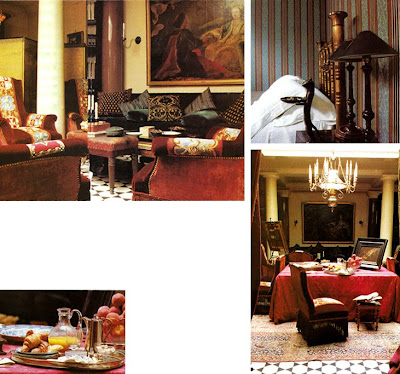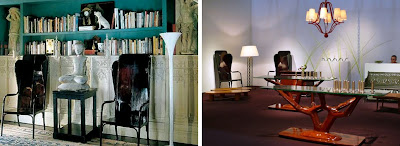A peak inside Paris antiquaire Maroun H. Salloum’s eclectic quarters
In another life he could have been his own best customer.
“I buy things for my gallery as if I were furnishing my own apartment,” sighs Maroun Salloum. “I want to keep it all, it’s bad for business.” Yet Salloum, a Seine-side Phoenician who spends most of the year traveling the world to find artifacts and objects that defy the everyday, has been the got-to antique dealer to well heeled collectors for over three decades.
 Antiques dealer Maroun H. Salloum relaxing in his Paris salon; In the corner of the salon is an “office” with an Empire style desk and 1940’s wicker chair, the wrought-iron ostrich is by Diego Giacometti and the portrait is late 16th century French; In Salloum’s shop a pair of 1860’s elk-horn chairs, a 17th century garden compass, and a 19th century painter’s portfolio propped up against a 19th century English mahogany bookcase; In the salon velvet curtains veil the main entrance, while a 19th century wrought-iron easel displays a Picasso still life.
Antiques dealer Maroun H. Salloum relaxing in his Paris salon; In the corner of the salon is an “office” with an Empire style desk and 1940’s wicker chair, the wrought-iron ostrich is by Diego Giacometti and the portrait is late 16th century French; In Salloum’s shop a pair of 1860’s elk-horn chairs, a 17th century garden compass, and a 19th century painter’s portfolio propped up against a 19th century English mahogany bookcase; In the salon velvet curtains veil the main entrance, while a 19th century wrought-iron easel displays a Picasso still life.
At the recent 20th International Fine Art & Antique Dealers Show, held at the Park Avenue Armory in New York, the topic on everyone’s mind was how the economy would affect sales, with many of the 61 exhibitors admitting that they did not expect to sell a single item. Yet Mr. Salloum’s booth was buzzing with activity and that may have had something to do with the unusual wares on display.
A couple eyed two gigantic mirrors from 1915 that looked as if they had been designed by Mondrian. Salloum had found them in the entrance hall of a Barcelona mansion. ''They were made by a man known as Jojol, a craftsman who did Gaudí's ironwork before he went out on his own,'' explained Mr. Salloum, who is known for his meticulous homework before purchasing a piece for his store. In the coarse of the day he would go on to sell a superb pair of 1940 sconces by Guglielmo Ulrich and textiles designed in 1906 by Mariano Fortuny in Venice.
Such is the magic eye of Maroun H. Salloum. A man known for buying the things he loves and then hiding them away in storerooms, until he pulls them out at just the right moment.
Back at his Paris shop, on the far end of a courtyard on the Quai Voltaire, Salloum reveals an Aladdin’s cave of objects from his travels; objects that may appear modest or pedigreed, but never commonplace. ''My taste isn't very French,'' explained Mr. Salloum, pointing to a pair of early cabinets by Adolf Loos, the Austrian architect and designer. While hanging on a wall nearby are seductive silver scones by Jacques-Emile Ruhlmann, a leading Parisian decorator and designer in the 1920's.
 In the salon, a 19th century English leather bench holds a bowl of ancient Egyptian Alabaster, and a 17th century Imari pot; the couch is covered in 1950’s velvet and a collection of 18th century cushions; the painting above is an 18th century portrait by Dandre Bardon; Salloum’s bedroom with it’s neo-Egyptian brass bed, wall fabric by Madeleine Castaing and a Giacometti cat sculpture; A breakfast table in the salon covered in 18th century damask; the carpet is a 19th century Kirman.
In the salon, a 19th century English leather bench holds a bowl of ancient Egyptian Alabaster, and a 17th century Imari pot; the couch is covered in 1950’s velvet and a collection of 18th century cushions; the painting above is an 18th century portrait by Dandre Bardon; Salloum’s bedroom with it’s neo-Egyptian brass bed, wall fabric by Madeleine Castaing and a Giacometti cat sculpture; A breakfast table in the salon covered in 18th century damask; the carpet is a 19th century Kirman.
Yet how this diminutive Lebanese gentleman became the Paris antique world’s best kept secret is an intriguing story in itself.
After studying architecture at the School of Fine Arts in Paris, Maroun set his sites on a career as an industrial designer. It was then that he started hunting for his first antiques to fund his firm. “When I was about twenty, I fell in love with a marble fragment I’d seen in a rue de Seine antiquaire and sold my small collection to buy it.” He never bought the fragment but used the money to buy other art objects instead. Four years later he would launch his own business. From then on he would spend most of his time roaming the world, tracking down rare objects from Prague to Paris, Moscow to Istanbul.
When Salloum declares that “My store is exactly like chez moi,” one senses that he is not over exaggerating. For it is at his rue Barbet-de-Jouy apartment where one can catch a glimpse of Salloum’s most prized possessions.
“A Picasso gouache hangs over a gilded 18th century couch, next to 17th century Japanese screens and the odd lot of Bohemian glassware. I’m a specialist in nothing. What interests me is foraging around fairs and flea markets to find off beat pieces and then using them to create a mise-en-scène,” explained Salloum, who has the liquid eyes characteristic of his fellow Lebanese.
 Many of the pieces Salloum discovers on his buying trips frequently end up at his Paris home before finding their way on the sales floor. One such example was a pair of armchairs designed by Josef Hoffman in 1905 (pictured above in his living room); The chairs, pictured again below in the left corner, would eventually resurface at Salloum’s booth at the International Antique Dealers Show at the Park Avenue Armory in New York, where they were eventually sold.
Many of the pieces Salloum discovers on his buying trips frequently end up at his Paris home before finding their way on the sales floor. One such example was a pair of armchairs designed by Josef Hoffman in 1905 (pictured above in his living room); The chairs, pictured again below in the left corner, would eventually resurface at Salloum’s booth at the International Antique Dealers Show at the Park Avenue Armory in New York, where they were eventually sold.
Not surprisingly Salloum’s apartment resembles a stage set, with its fifteen foot columns and gigantic potted palms. “My apartment acts on the same principle as a New York loft; there’s a miniscule bedroom, dressing room, bathroom and kitchen. Everything else happens here in this thousand square foot room,” said Salloum, as his French bulldog, Corto, lay asleep in a wicker basket looking like part of the salon’s décor.
By the time Salloum bought his apartment on the ground floor of an 18th century hotel particulier, the salon had already passed through several incarnations. It began as the mansion’s outdoor courtyard, (underneath the dinning table one will find the original shallow marble pool, which Salloum camouflaged with fake flooring and an early 19th century Kirman rug). In 1960, after the courtyard was enclosed (in part with glass, which bathes the room in an eerie aquatic light) it became the atrium for the family ballroom.
Balls may be a thing of the past, but Lebanese dinners for six to twenty four people are very much part of Salloum’s present. A folding six by nine foot table covered in a length of 18th century damask serves variously as a breakfast table, office and buffet for the masses of friends and family who arrive (sometimes without warning) to sample Salloum’s renowned “Lebano-Franco-Italian cuisine.”
Even after being in Paris for a over thirty years (Salloum came from Beirut in 1974), he confides that he’s still “very Mediterranean.” “I get up every morning at seven to deal with my artisans, but I insist on having two hours for lunch! A meal should be a party,” he says laughing. “I like to place three of my big 18th century Japanese pots in a row down the center of the table, or use a huge rhododendron that nearly touches the chandelier.” He adds, “You can’t be modest when you invite two dozen people for dinner.”
Salloum attributes his eclecticism to his childhood in Beirut, “an oriental port city,” where treasures from the Ottoman Empire, China, and 19th century Europe all washed up. His origins are further revealed in a penchant for 18th century Turkish glassware and embroidered Syrian table linens. “Life is an assemblage,” says this master of the artful mélange. “And I love to mix!”
© THE POLYGLOT (all rights reserved) CHICAGO-PARIS
In another life he could have been his own best customer.
“I buy things for my gallery as if I were furnishing my own apartment,” sighs Maroun Salloum. “I want to keep it all, it’s bad for business.” Yet Salloum, a Seine-side Phoenician who spends most of the year traveling the world to find artifacts and objects that defy the everyday, has been the got-to antique dealer to well heeled collectors for over three decades.
 Antiques dealer Maroun H. Salloum relaxing in his Paris salon; In the corner of the salon is an “office” with an Empire style desk and 1940’s wicker chair, the wrought-iron ostrich is by Diego Giacometti and the portrait is late 16th century French; In Salloum’s shop a pair of 1860’s elk-horn chairs, a 17th century garden compass, and a 19th century painter’s portfolio propped up against a 19th century English mahogany bookcase; In the salon velvet curtains veil the main entrance, while a 19th century wrought-iron easel displays a Picasso still life.
Antiques dealer Maroun H. Salloum relaxing in his Paris salon; In the corner of the salon is an “office” with an Empire style desk and 1940’s wicker chair, the wrought-iron ostrich is by Diego Giacometti and the portrait is late 16th century French; In Salloum’s shop a pair of 1860’s elk-horn chairs, a 17th century garden compass, and a 19th century painter’s portfolio propped up against a 19th century English mahogany bookcase; In the salon velvet curtains veil the main entrance, while a 19th century wrought-iron easel displays a Picasso still life.At the recent 20th International Fine Art & Antique Dealers Show, held at the Park Avenue Armory in New York, the topic on everyone’s mind was how the economy would affect sales, with many of the 61 exhibitors admitting that they did not expect to sell a single item. Yet Mr. Salloum’s booth was buzzing with activity and that may have had something to do with the unusual wares on display.
A couple eyed two gigantic mirrors from 1915 that looked as if they had been designed by Mondrian. Salloum had found them in the entrance hall of a Barcelona mansion. ''They were made by a man known as Jojol, a craftsman who did Gaudí's ironwork before he went out on his own,'' explained Mr. Salloum, who is known for his meticulous homework before purchasing a piece for his store. In the coarse of the day he would go on to sell a superb pair of 1940 sconces by Guglielmo Ulrich and textiles designed in 1906 by Mariano Fortuny in Venice.
Such is the magic eye of Maroun H. Salloum. A man known for buying the things he loves and then hiding them away in storerooms, until he pulls them out at just the right moment.
Back at his Paris shop, on the far end of a courtyard on the Quai Voltaire, Salloum reveals an Aladdin’s cave of objects from his travels; objects that may appear modest or pedigreed, but never commonplace. ''My taste isn't very French,'' explained Mr. Salloum, pointing to a pair of early cabinets by Adolf Loos, the Austrian architect and designer. While hanging on a wall nearby are seductive silver scones by Jacques-Emile Ruhlmann, a leading Parisian decorator and designer in the 1920's.
 In the salon, a 19th century English leather bench holds a bowl of ancient Egyptian Alabaster, and a 17th century Imari pot; the couch is covered in 1950’s velvet and a collection of 18th century cushions; the painting above is an 18th century portrait by Dandre Bardon; Salloum’s bedroom with it’s neo-Egyptian brass bed, wall fabric by Madeleine Castaing and a Giacometti cat sculpture; A breakfast table in the salon covered in 18th century damask; the carpet is a 19th century Kirman.
In the salon, a 19th century English leather bench holds a bowl of ancient Egyptian Alabaster, and a 17th century Imari pot; the couch is covered in 1950’s velvet and a collection of 18th century cushions; the painting above is an 18th century portrait by Dandre Bardon; Salloum’s bedroom with it’s neo-Egyptian brass bed, wall fabric by Madeleine Castaing and a Giacometti cat sculpture; A breakfast table in the salon covered in 18th century damask; the carpet is a 19th century Kirman.Yet how this diminutive Lebanese gentleman became the Paris antique world’s best kept secret is an intriguing story in itself.
After studying architecture at the School of Fine Arts in Paris, Maroun set his sites on a career as an industrial designer. It was then that he started hunting for his first antiques to fund his firm. “When I was about twenty, I fell in love with a marble fragment I’d seen in a rue de Seine antiquaire and sold my small collection to buy it.” He never bought the fragment but used the money to buy other art objects instead. Four years later he would launch his own business. From then on he would spend most of his time roaming the world, tracking down rare objects from Prague to Paris, Moscow to Istanbul.
When Salloum declares that “My store is exactly like chez moi,” one senses that he is not over exaggerating. For it is at his rue Barbet-de-Jouy apartment where one can catch a glimpse of Salloum’s most prized possessions.
“A Picasso gouache hangs over a gilded 18th century couch, next to 17th century Japanese screens and the odd lot of Bohemian glassware. I’m a specialist in nothing. What interests me is foraging around fairs and flea markets to find off beat pieces and then using them to create a mise-en-scène,” explained Salloum, who has the liquid eyes characteristic of his fellow Lebanese.
 Many of the pieces Salloum discovers on his buying trips frequently end up at his Paris home before finding their way on the sales floor. One such example was a pair of armchairs designed by Josef Hoffman in 1905 (pictured above in his living room); The chairs, pictured again below in the left corner, would eventually resurface at Salloum’s booth at the International Antique Dealers Show at the Park Avenue Armory in New York, where they were eventually sold.
Many of the pieces Salloum discovers on his buying trips frequently end up at his Paris home before finding their way on the sales floor. One such example was a pair of armchairs designed by Josef Hoffman in 1905 (pictured above in his living room); The chairs, pictured again below in the left corner, would eventually resurface at Salloum’s booth at the International Antique Dealers Show at the Park Avenue Armory in New York, where they were eventually sold.Not surprisingly Salloum’s apartment resembles a stage set, with its fifteen foot columns and gigantic potted palms. “My apartment acts on the same principle as a New York loft; there’s a miniscule bedroom, dressing room, bathroom and kitchen. Everything else happens here in this thousand square foot room,” said Salloum, as his French bulldog, Corto, lay asleep in a wicker basket looking like part of the salon’s décor.
By the time Salloum bought his apartment on the ground floor of an 18th century hotel particulier, the salon had already passed through several incarnations. It began as the mansion’s outdoor courtyard, (underneath the dinning table one will find the original shallow marble pool, which Salloum camouflaged with fake flooring and an early 19th century Kirman rug). In 1960, after the courtyard was enclosed (in part with glass, which bathes the room in an eerie aquatic light) it became the atrium for the family ballroom.
Balls may be a thing of the past, but Lebanese dinners for six to twenty four people are very much part of Salloum’s present. A folding six by nine foot table covered in a length of 18th century damask serves variously as a breakfast table, office and buffet for the masses of friends and family who arrive (sometimes without warning) to sample Salloum’s renowned “Lebano-Franco-Italian cuisine.”
Even after being in Paris for a over thirty years (Salloum came from Beirut in 1974), he confides that he’s still “very Mediterranean.” “I get up every morning at seven to deal with my artisans, but I insist on having two hours for lunch! A meal should be a party,” he says laughing. “I like to place three of my big 18th century Japanese pots in a row down the center of the table, or use a huge rhododendron that nearly touches the chandelier.” He adds, “You can’t be modest when you invite two dozen people for dinner.”
Salloum attributes his eclecticism to his childhood in Beirut, “an oriental port city,” where treasures from the Ottoman Empire, China, and 19th century Europe all washed up. His origins are further revealed in a penchant for 18th century Turkish glassware and embroidered Syrian table linens. “Life is an assemblage,” says this master of the artful mélange. “And I love to mix!”
© THE POLYGLOT (all rights reserved) CHICAGO-PARIS

No comments:
Post a Comment